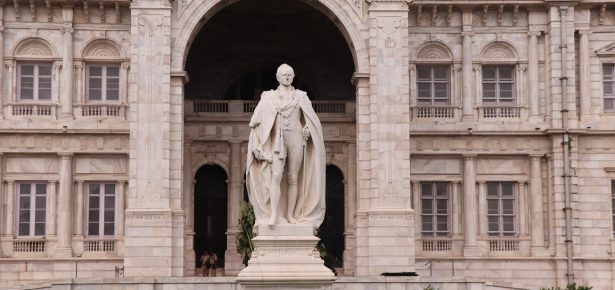
Travelling between the cities of the former British empire can produce an uncanny sense of déjà vu: despite vast social, cultural and environmental differences, you’ll see familiar street names and statues, clock towers and law courts, missionary churches and schools, cricket grounds and botanical gardens. Linking a global network of cities, colonial iconography and urban planning helped to concretise imperial dreams about the spread of English culture, cementing fantasies of imperialism as a benevolent process of mimetic transfer. Yet even as planners embraced aspirational visions of colonial cities as English replicas (the ‘Liverpool of West Africa’ or the ‘Manchester of the East’), their attempts to paper over the systemic, racialised inequalities of colonial rule became increasing tenuous. This was especially apparent when a global health crisis swept through the Empire’s ‘plague ports’, from Hong Kong and Bombay to Rangoon, Singapore, Cape Town and Lagos, among others, from the 1890s into the 1920s. As new development boards were established across these cities, planners and sanitation specialists pioneered low-cost strategies of medicalised urban planning that segregated wealthy, hilltop residential enclaves from overcrowded harbour districts, many of which were built on flood-prone and ecologically precarious reclamation areas. Responding to stark inequalities, strikes and protests erupted across a series of colonial ports in the decolonising decades of the twentieth century. As colonial monuments were defaced and flag-raising ceremonies disrupted, these cities came to magnify the contradictions at the heart of empire’s universalising claims, becoming battlegrounds in the struggles over colonial meanings.
Because of their symbolic importance, the urban landscapes of the late British empire are key locations in which to read colonial narratives and counter-narratives. Modernism in the Metrocolony shows how, among a group of twentieth-century writers, urban experiences in diverse yet connected cities generated important critical and formal innovations, challenging the developmental assumptions at work in urban discourses of the period. The book argues that the complexities of a metrocolonial modernity – defined as an urban experience in regions with a self-consciously peripheral relationship to imperial metropolitan culture and institutions – shaped some of the aesthetic and critical concerns that we associate with literary modernism. While scholars have shown how modernist writers were influenced by the cosmopolitan cultures of London, Paris or New York, colonial capitals were important material and institutional sites that allowed intellectuals and artists to mediate between their own networks and those of the imperial centre, often via semi-peripheral institutions such as missionary schools and universities, presses and cultural organisations. The languages of these institutions, and the alienating qualities of their metropolitan discourses, find their way into the subversive, polyphonic voices of metrocolonial texts.
Offering the first book-length study of the British colonial city in Anglophone literature, Modernism in the Metrocolony emphasises the role of everyday experience in the colonial metropolis. Focusing on diverse yet relational metrocolonial sites – from Joseph Conrad’s impressionistic Singapore to the dissonances of Joyce’s Dublin, and from the uneven Bombay imagined by Anglo-Indian writers to the submerged port capital invoked in independence-era Fiji – it shows how the colonial metropolis becomes the stage for jarring moments inspired by the strange incongruities, misplaced ideas and ‘unreal’ superimpositions of everyday urban life. Staging disruptive episodes in which, for example, a grand, palm-lined promenade sinks into reclaimed swampland, or a marble statue of Queen Victoria is occupied by rickshaw pullers, writers confront the aspirational ideals monumentalised in the urban landscape with the visual contradictions on display in the city streets. Juxtaposing tramways and cattle lines, military troops and medieval markets, cricket lawns and temples, boulevards and swamps, they incorporate the unevenness of the city’s modernity into the formal texture of their work. In this way, modernism’s fusion of the classical and the contemporary is seen to respond to the lived coevalities and multiple temporalities of the metrocolony, articulating a complex, elusive and paradoxical experience of the modern.
Latest Comments
Have your say!